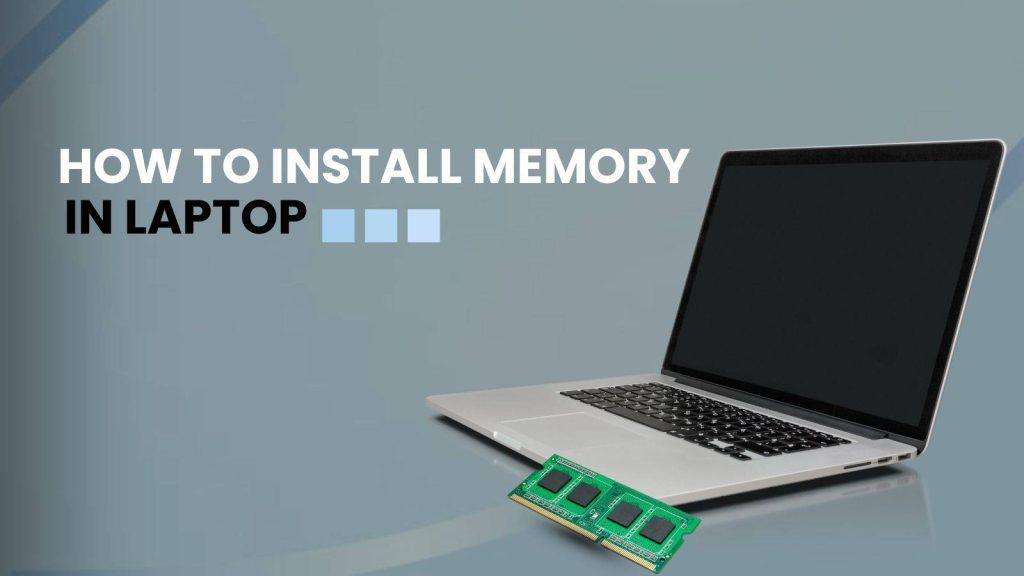Upgrading your laptop memory (RAM) is one of the most effective ways to improve system performance without replacing your device. Whether your laptop struggles with multitasking, large software, or modern games, adding RAM can make a noticeable difference.
Find step by step through how to install memory in a laptop, covering all major brands including Dell, HP, Lenovo, Asus, Acer, and Apple. Here are practical tips, troubleshooting advice, and expert insights for both beginners and advanced users.
How to Check Your Laptop’s RAM Compatibility
Installing RAM without checking compatibility can lead to crashes, instability, or system failure. Here’s how to ensure your laptop can support a memory upgrade:
- Check current RAM: On Windows, go to
Task Manager → Performance → Memoryto view your RAM size, type (DDR3/DDR4/DDR5), speed (MHz), and slot usage. On Mac, checkAbout This Mac → Memory. Linux users can use the terminal commandfree -h.
- Maximum supported RAM: Consult your laptop’s manual or the manufacturer’s website to determine maximum RAM capacity. For example, older laptops may support only up to 16GB, while modern models can handle 32GB, 64GB, or even 128GB.
- RAM type, form factor, and speed: Most laptops use SO-DIMM modules. Matching DDR type, speed, and voltage ensures stability. Mismatched RAM can result in system crashes or slower performance.
- Compatibility tools: Tools like Crucial Memory Advisor, Kingston Memory Finder, and CPU-Z can detect compatible RAM and recommend optimal upgrades.
- Operating System Limits: Remember that older versions of Windows (e.g., Windows 10 Home 32-bit) cannot address more than 4GB RAM, even if physically installed.
Extra Tip: When upgrading, consider buying RAM slightly faster than your current module if your laptop supports it. This can improve multitasking and responsiveness in modern applications.
Tools Required to Install Laptop Memory
Having the correct tools ensures safety and smooth installation. While RAM installation is simple, the wrong tools can cause damage.
- Small Phillips-head screwdriver: Most laptops have tiny screws; using the correct size prevents stripping.
- Anti-static wrist strap: Protects delicate motherboard components from electrostatic discharge (ESD), which can permanently damage memory chips.
- Clean workspace: Use a flat surface with a soft cloth to prevent scratches and organize screws.
- Optional: Compressed air for cleaning RAM slots and vents, improving connection and cooling efficiency.
- Flashlight or headlamp: Useful for seeing into narrow slots, especially in laptops with complex layouts.
Pro Tip: Avoid working on carpets or in low-humidity areas. Static is more likely to occur and can damage RAM instantly.
Preparing Your Laptop for RAM Installation
Proper preparation reduces risks of damage and installation errors.
1. Shut down and unplug: Never attempt to install RAM with the laptop powered on.
2. Remove the battery (if removable): Prevents any residual electricity from damaging components.
3. Discharge static electricity: Wear an anti-static wrist strap or touch a grounded metal object. Even minor static can permanently damage sensitive chips.
4. Organize screws and parts: Use small containers or magnetic mats to avoid losing screws.
Extra Tip: Clean the RAM slot gently using compressed air to remove dust or debris. Poor electrical contact can result in the new RAM not being detected.
Locating the RAM Slots in Different Laptop Brands
Finding the RAM slots varies by brand, model, and even sub-model:
- Windows laptops (Dell, HP, Lenovo, Asus, Acer): Typically under a back panel secured with screws. Some ultrabooks have soldered RAM that cannot be upgraded.
- Apple MacBooks: Older Intel-based MacBooks have accessible RAM slots; M1 and M2 models have soldered RAM, so upgrades are not possible.
- Single vs. dual slots: Dual slots enable dual-channel mode, which increases memory bandwidth and improves system performance.
- Hidden slots: Some laptops require removing the keyboard or additional panels. Always refer to the service manual or teardown video for exact instructions.
Pro Tip: Check for “SO-DIMM” labels or diagrams near slots. Proper identification avoids misinstallation and potential damage.
Step-by-Step Guide to Installing RAM
Installing RAM requires care to prevent damage to both the memory module and motherboard:
1. Open the back panel: Use the correct screwdriver. Avoid forcing the panel, as plastic clips can break.
2. Locate RAM slots: Identify available slots or determine which modules to replace. Release old RAM by gently pressing the side clips outward.
3. Insert new RAM: Align the notch, insert at a 30-degree angle, then press down until the side clips click securely.
4. Check seating: RAM should be firmly seated; loose modules can cause boot failure, freezes, or blue screens.
5. Reassemble laptop: Carefully replace screws and panels. Avoid over-tightening screws, which can strip threads.
Extra Tip: Always install RAM by the edges, avoiding contact with gold pins. If installing multiple modules, consult the motherboard manual for optimal slot arrangement to enable dual-channel mode.
Checking Installed RAM After Installation
After installation, it’s essential to verify the system recognizes the new memory:
- Windows: Open
Task Manager → Performance → Memoryto confirm total RAM. - Mac: Go to
About This Mac → Memoryto verify detection. - BIOS/UEFI: Reboot and check RAM recognition. Some systems require enabling XMP profiles for full speed.
Troubleshooting Tips:
- If RAM is not detected, reseat it or try a different slot.
- Ensure the RAM is compatible with your laptop model and supported speed.
- Update BIOS if your laptop cannot recognize new RAM.
Tips for Optimal RAM Performance
Correct configuration maximizes system performance:
- Dual-channel mode: Install identical RAM sticks in paired slots to double bandwidth.
- Match speed and capacity: Mismatched sticks can reduce performance and system stability.
- Enable XMP in BIOS: Activating XMP (Extreme Memory Profile) unlocks rated RAM speeds for optimal performance.
- Regular maintenance: Dust in RAM slots can reduce performance; clean periodically.
- Use monitoring software: Applications like CPU-Z can monitor RAM speed, usage, and channels to ensure everything is functioning correctly.
Extra Insight: Higher RAM not only improves multitasking but also reduces reliance on slow pagefile or swap memory, which enhances gaming, rendering, and professional workloads.
Common Mistakes to Avoid While Installing Laptop Memory
Avoid these mistakes to ensure a smooth installation:
- Using incompatible RAM type, speed, or voltage
- Ignoring anti-static precautions
- Forcing RAM into slots
- Skipping reseating or proper securing of modules
- Not verifying BIOS/UEFI detection
Pro Tip: Watch model-specific installation videos to understand your laptop’s internal layout. Many problems arise from unfamiliarity with the device.
Even beginners can confidently upgrade their RAM, turning a sluggish laptop into a faster, more capable device for work, gaming, or creative projects, without the cost of buying a new laptop.
FAQs
Q1: Can I upgrade the RAM on any laptop?
Not all laptops support RAM upgrades. Most Windows laptops with removable panels allow upgrades, but ultrabooks, MacBooks with M1/M2 chips, and some modern thin-and-light laptops have soldered RAM that cannot be replaced. Always check your laptop’s specifications or manufacturer documentation before purchasing new RAM.
Q2: How do I know which RAM is compatible with my laptop?
Check your laptop’s manual or use online compatibility tools like Crucial Memory Advisor or Kingston Memory Finder. Key factors include RAM type (DDR3, DDR4, DDR5), speed (MHz), form factor (SO-DIMM for laptops), and maximum supported capacity per slot. Installing incompatible RAM can cause boot failure or system instability.
Q3: How many RAM slots does my laptop have, and how many should I use?
Most laptops have 1–2 RAM slots, though some high-end models have 4. For optimal performance, especially for dual-channel operation, use identical RAM sticks in paired slots. Your laptop’s manual or system info tool (e.g., CPU-Z) can show slot count and current usage.
Q4: Will installing new RAM void my laptop warranty?
Typically, installing compatible RAM does not void warranty, but improper installation (damaging the motherboard, using incompatible RAM) might. Always follow manufacturer guidelines and avoid forcing modules into slots.
Q5: What tools do I need to safely install RAM in a laptop?
You need a small Phillips-head screwdriver to open the back panel, an anti-static wrist strap to prevent electrostatic discharge (ESD), a clean workspace, and optionally compressed air to remove dust from slots. Avoid working on carpeted or dry surfaces.
Q6: How do I physically install RAM in a laptop?
After powering off and unplugging the laptop:
- Remove the back panel and locate RAM slots.
- If replacing, release existing modules by gently pushing side clips outward.
- Insert new RAM at a 30-degree angle, aligning the notch, and press until clips snap into place.
- Reassemble the back panel and power on the laptop.
Q7: How do I verify that my laptop recognizes the new RAM?
- Windows: Open Task Manager → Performance → Memory.
- Mac: About This Mac → Memory.
- BIOS/UEFI: Access during boot to ensure RAM is detected and running at the correct speed. If it’s not detected, reseat the module or check compatibility.
Q8: Can I mix RAM sticks with different brands or speeds?
Yes, but mixing different speeds may prevent dual-channel operation, and mismatched sizes can reduce stability. For optimal performance, use identical RAM sticks (same brand, speed, and capacity) in paired slots.
Q9: Is upgrading RAM worth it for gaming or professional work?
Absolutely. Modern games, video editing, 3D rendering, virtual machines, and heavy multitasking benefit from additional RAM. Increasing RAM reduces system reliance on slower storage, improving responsiveness and frame rates.
Q10: My laptop won’t boot after installing RAM – what should I do?
Common troubleshooting steps:
- Power off and reseat the RAM.
- Verify compatibility (type, speed, size).
- Try a different slot.
- Reset BIOS/UEFI settings or update BIOS firmware.
If issues persist, test each RAM module individually to identify defective sticks.




